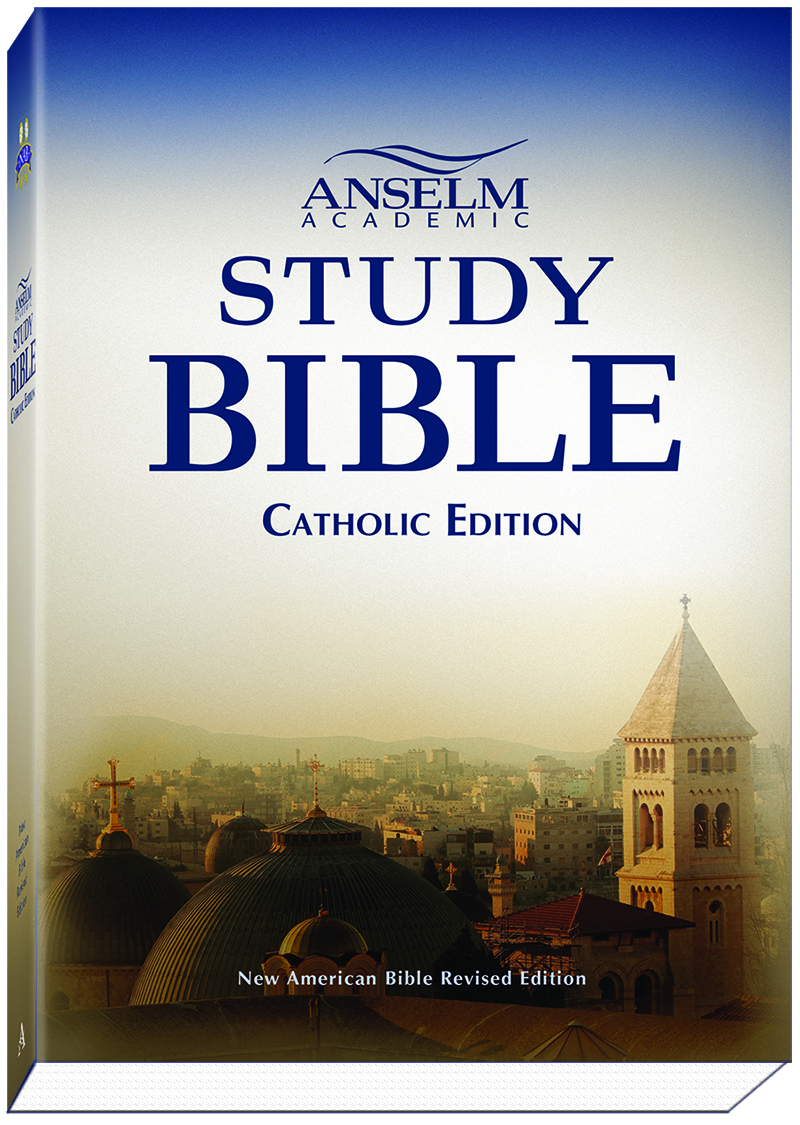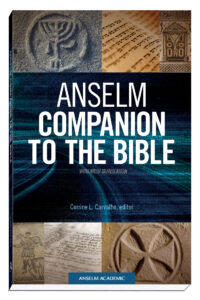Anselm Academic Study Bible
Catholic Edition
About This Book
Overview
Equipped with wide-ranging features—from basic introductions to scholarly articles, and from photographs and maps to informative study aids—the Anselm Academic Study Bible is designed to meet the diverse needs of the modern classroom.
Its expert translation, rigorous scholarship, and ease of navigation means every student—whether already familiar with the text or approaching it for the first time—will feel confident and comfortable exploring the Bible.
KEY FEATURES
- Distinctive Approach:
The Study Bible engages a diverse audience in critical thinking
- Rigorous Scholarship:
Expert and emerging scholars present the latest research on the most relevant topics
- Navigation-Friendly Organization:
Intuitively designed to make navigation easy for those familiar with or new to the Bible
- Rich Academic Support Materials:
Photographs, charts, maps, timelines, and additional recommended online resources
Details
| Weight | 3 lbs |
|---|---|
| Dimensions | 6.375 × 1.5 × 8.875 in |
| Format | Softcover |
| Print ISBN | 978-1-59982-124-5 |
| Pages | 2162 |
| Item # | 4142 |
|---|
Customer Reviews
“The Anselm Academic Study Bible . . . could easily serve as a text for teaching an introduction to the Old or New Testament. The charts, maps, and diagrams provide visual and graphic interpretation, and the supplemental information, like a listing of deities of the ancient Near East, offers the insight that students find fascinating. This is a great Bible.”
“The Anselm Academic Catholic Study Bible is a very fine, one-volume Bible. On top of the freshly updated NABRE Bible translation, with its wonderful footnotes, the additional book introductions provide just the right amount of historical and thematic context to prime new readers to listen for what the inspired author wanted them to hear. The 13 articles at the front of the volume give the academically minded reader helpful background on the Bible’s origins, interpretive methods, and big-picture ideas that reach beyond the individual books of the Sacred Scriptures. This is an excellent text and tool chest for the hungry Catholic whether at school, church, or home.”
“As a pastor, I would recommend the Anselm Academic Catholic Study Bible to those in a Bible study, to all high school students in faith formation classes referring to the Bible, and to anyone wishing to better understand the context of the Bible so they can have a greater grasp of the Word of God.”
“The Anselm Academic Catholic Study Bible presents the text of the revised New American Bible (NAB) with fresh introductions and notes by an impressive array of renowned Scripture scholars. There are excellent articles on a wide range of Bible-related issues, ranging from canonicity and archaeology to lectionary provision and different patterns of biblical interpretation. Attractive maps, images, and helpful charts complete this rich array of educational resources. Accessible and authoritative, I recommend Anselm Academic Catholic Study Bible enthusiastically not only to seminarians and students in Bible courses, but also to clergy and interested lay readers.”
“Among study Bibles, the Anselm Academic Catholic Study Bible stands out for its excellent translation and notes (New American Bible Revised Edition), fresh introductions to the biblical books, and articles on important and neglected topics such as the social context of the Bible, the Christian Bible and Jews, and contextual and transformative interpretation. Expertly edited and amply illustrated, the volume is a most welcome resource for students and interested adults.”
” . . . the best of biblical scholarship today. . . . Among the real strengths is the careful attention to the contexts of biblical literature by means not only of detailed exposition of ancient attitudes and worldviews, but also charts, maps, and beautiful images. . . . I will be recommending the Anselm Academic Catholic Study Bible to students, ministerial candidates, clergy, and all those interested in serious academic study of the Bible. I know of nothing quite like it!”
Table of Contents
The Anselm Academic Study Bible uses the New American Bible – Revised Edition (NABRE) as its core and includes introductions and academic articles written by established and emerging Scripture scholars as well as maps and charts. These informative and accessible resources are listed below:
ARTICLES
The Formation of the Bible
James Chukwuma Okoye, CSS
Geography, Archaeology, and the Scriptures
Leslie J. Hoppe, OFM
Social Context of the Bible
Eric Stewart
Deuterocanonical and Noncanonical Scriptures
John Endres, SJ (OT), François Bovon (NT)
The Christian Bible and the Jews
Mary C. Boys
Jewish Biblical Interpretation
Amy-Jill Levine
The Distinctiveness of Jesus
Seán Charles Martin
The Many Faces of Jesus
Seán Charles Martin
The Lectionary: A Canon within the Canon
Regina Boisclair
A Brief History and Practice of Biblical Criticism
Marielle Frigge, OSB
Critical Issues in Contemporary Biblical Interpretation
Stephen J. Binz and Anselm Academic
Sacred Scripture in the Catholic Tradition
Stephen J. Binz
Contextual and Transformative Interpretation
Stephen J. Binz
BIBLE CONTRIBUTERS INCLUDE: Patricia Ahearne-Kroll, Dianne Bergant, Stephen J. Binz, Mary Katherine Birge, Regina Boisclair, François Bovon Frothingham, Mary C. Boys, Laurie Brink, Susan Calef, Warren Carter, Raymond F. Collins, Mary Coloe, Linda Day, Carol J. Dempsey, John Endres, Garrett Galvin, Andrew T. Glicksman, Michael D. Guinan, Leslie J. Hoppe, James A. Kelhoffer, Dale Launderville, Amy-Jill Levine, Seán Charles Martin, Geoffrey Miller, Harry P. Nasuti, James Chukwuma Okoye, Clare K. Rothschild, Jean-Pierre Ruiz, Eric Stewart, Pauline A. Viviano, Jerome Walsh, Tatha Wiley, and Christine Roy Yoder
MAPS
The Israelite Kingdoms
Neo-Babylonian Empire, ca. Sixth Century BCE
The Table of Nations
The Tribal Territories
The Kingdom Years
The Assyrian Empire
The Babylonian Empire
Roman Empire in First Century CE
Palestine at the Time of Jesus
Jerusalem of David & Solomon; Jerusalem after the Exile; Jerusalem in Jesus’ Time
Paul’s Journeys in Acts (First and Second Journeys)
Paul’s Journeys in Acts (Third and Fourth Journeys)
Ministry of Jesus and Acts of the Apostles
The Holy Land in Modern Times
CHARTS
Deities of the Ancient Near East
Spiritual Ancestors of the Monotheistic Faiths
Prophets and Kings
Wonders, Miracles, and Signs in the Old Testament
Sacred Time: Festivals, Feasts, and Fasts of Judaism Practiced by Jesus, the Apostles, and Their Contemporaries
Greco-Roman Rulers in the New Testament Period
Titles of Jesus of Nazareth
Wonders, Miracles, and Signs in the New Testament
The Men Who Followed Jesus
The Women Who Followed Jesus
Beatitudes and Parables of Jesus
The Historical-Critical Method of Scripture Analysis
A Chart of the Literature Associated with Ezra
The Gospel of Luke and Acts
Professional Reviews
ANSELM ACADEMIC STUDY BIBLE: Catholic Edition: New American Bible Revised Edition (NABRE) 2015. Anselm Academic, 702 Terrace Heights, Winona, MN 55987-1320 paperbound 398 Pages $43.95 ISBN 978-1-59982-632-5 www.anselmacademic.org.
Organized and developed with the twenty-first reader in mind, the Anselm Academic Study Bible is a late entry into useful and informative editions of the New American Bible Revised Edition that will be welcomed especially by Roman Catholics yet valuable for all Christians. In addition to its excellent translation and notes, it has articles on important and neglected topics such the social context of the Bible, the Christian Bible and Jews, and Contextual and Transformative Interpretation. Other topics in the in-depth, scholarly articles by thirteen writers are informative and compelling features of this Bible. They are The Formation of the Bible; Geography, Archaeology, and the Scriptures; Deuterocanonical and Noncanonical Scriptures; Jewish Biblical Interpretation; The Distinctiveness of Jesus; The Many Faces of Jesus; The Lectionary: A Canon within the Canon; A Brief History and Practice of Biblical Criticism; Critical Issues in Contemporary Interpretation; and Sacred Scripture in the Catholic Tradition. Other important features of this complete study Bible are Engaging scholarship. Recognized and emerging scholars, all expert teachers, present the best and latest research on the formation and interpretation of the Bible. Distinctive approach. Addresses diverse readership and sound pedagogy that encourages critical thinking and informed dialogue. Navigation-friendly organization. Two introductions immediately precede each biblical book, and other resources are sensibly and accessibly arranged. Rich support materials. Full-color and black-and-white photographs, charts, maps, and timelines enhance learning, with online resources available as well. The NABRE is the first major update of the New American Bible (NAB) in twenty years. Reflecting the work of nearly 100 scholars and extensively reviewed and approved by the United States Conference of Catholic Bishops, it takes into account the best current scholarship as newly discovered ancient manuscripts improve knowledge and understanding of the biblical text. A statement on the copyright page states, “It is permitted by the undersigned [bishops] for private use and study.” In any case, it is a welcome addition to the many new translations and revisions being published, some commemorating the 400th anniversary of the King James Bible in 2011. The difference between the New American Bible Revised Edition and the New American Bible is that the NABRE is considered to be more verbally equivalent and the NAB more dynamically equivalent, although like most modern translations, each has elements of both translation philosophies. These words to the Pontifical Biblical Commission’s preface to its Interpretation of the Bible in the Church is apt: “This study is never finished; each age must in its own way newly seek to understand the sacred books.”
Anselm Academic Study Bible This study Bible contains the full text of the New American Bible Revised Edition along with introductory articles on the formation of the Bible (J. C. Okoye); geography, archaeology, and the Scriptures (L. J. Hoppe); the social context of the Bible (E. Stewart); Deuterocanonical and non- canonical Scriptures (F. Bovon, J. Endres); the Christian Bible and the Jews (M. C. Boys); Jewish biblical interpretation (A.-J. Levine); the distinctiveness of Jesus (S. C. Martin); the many faces of Jesus (Martin); the lectionary (R. Boisclair); a brief history and practice of biblical criticism (M. Frigge); critical issues in contemporary biblical interpretation (S. J. Binz); sacred Scripture in the Catholic tradition (Binz); and contextual and transformative interpretation (Binz). The treatment of each biblical book includes introductions, the English text, and notes. The NT writings are presented by M. K. Birge (Hebrews, James, 12 Peter, 13 John, Jude), L. Brink (Romans, 12 Corinthians), W. Carter (Matthew), R. F. Collins (Ephesians, Colossians, 12 Timothy, Titus), M. Coloe (John), J. A. Kelhoffer (Mark), C. L. Rothschild (Luke, Acts), J.-P. Ruiz (Revelation), and T. Wiley (Galatians, Philippians, 12 Thessalonians, Philemon). Maps, charts, and photo- graphs are included as additional study aids. Hoppe served as associate editor for the OT
Before presenting the full text and footnotes to the New American Bible Revised Edition (NABRE), the Anselm Academic Study Bible provides a series of articles such as The Formation of the Bible, Geography, Archaeology, and the Scriptures, Social Context of the Bible, and The Distinctiveness of Jesus, where each article (and more!) contain highly interesting and helpful information. For example, the article on geography lets us know the territory controlled by the ancient Israelite kingdoms was relatively small about the size of New Jersey. And, in Social Context, we realize that All of the cultures of the ancient Near East, along with Greek and Roman cultures, were honor cultures where that status could be earned or achieved, which explains why King Saul, who had been victorious over thousands, became paranoid over David, who was honored for conquering tens of thousands. In The Formation of the Bible, we discover that the Septuagint or Greek Bible was widely read during Jesus time and, therefore, provided over 90 percent of the Old Testament verses quoted in the New Testament. Although Catholic Bibles follow that translation, others do not, making the Apocrypha a source of confusion among various denominations. However, the article on Deuterocanonical and Noncanonical Scriptures not only explains this well but mentions various books written during Bible times that were not canonized but became a source of folktales and thought-provoking information not found in scripture.Equally interesting, the article on Jewish Biblical Interpretation gives insight into common methods of study, biblical analysis, and interpretative thinking such as allegory, numeric value, and typology where something on earth represents a type of reality found in heaven. In addition, Jewish and non-Jewish interpreters familiar with earlier Jewish commentary draw on rabbinic/ midrashic interpretation, with its attention to multiple meanings, plays on words, and intertextual conversations, to enhance literary-critical approaches. Understanding Jesus Jewish heritage helps us to recognize The Many Faces of Jesus as seen by early Christians and Gospel writers who came to understand the person and mission of Jesus as the new Adam, the new Son of David, the new Passover, and the New Covenant that the Hebrew Scriptures foretold. With this foundation, were better equipped to approach A Brief History and Practice of Biblical Criticism with its methods of studying the Bible through history, textual comparisons, translations, forms, sources, intent, and/or unifying themes. As the article on Contextual and Transformative Interpretation explains, different types of meaning within biblical texts might focus on The messianic meaning, The canonical meaning, or The communal meaning,” but One can read the Bible primarily for information, that is, to be intellectually enlightened, or for transformation, that is, to be personally changed. Regarding the latter, This integration of the meaning of the text and the world of the reader is the ultimate goal of interpretation. With meditative prayer or communal worship, the biblical texts become more personal and immediate, for example, through Lectio Divina.A subheading on The Tradition of Lectio Divina offers these bullet points for us to consider and live out: Lectio Reading the Text with a Listening Ear. Meditatio Reflecting on the Meaning and Message of the Text. Oratio Praying in Response to Scripture. Contemplatio Quietly Resting in God. Operatio Faithful witness in Daily Life.





